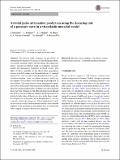| dc.contributor.author | Menacho, J. | |
| dc.contributor.author | Rotllant, L. | |
| dc.contributor.author | Molins, J. J | |
| dc.contributor.author | Reyes, G. | |
| dc.contributor.author | García-Granada, A. A | |
| dc.contributor.author | Martorell, J. | |
| dc.contributor.author | Molins, J. J. | |
| dc.contributor.author | García-Granada, A. A. | |
| dc.contributor.author | Balcells-Camps, Mercedes | |
| dc.date.accessioned | 2018-03-28T16:20:47Z | |
| dc.date.available | 2018-03-28T16:20:47Z | |
| dc.date.issued | 2017-11 | |
| dc.date.submitted | 2017-07 | |
| dc.identifier.issn | 1617-7959 | |
| dc.identifier.issn | 1617-7940 | |
| dc.identifier.uri | http://hdl.handle.net/1721.1/114428 | |
| dc.description.abstract | The present study examines the possibility of attenuating blood pulses by means of introducing prosthetic viscoelastic materials able to absorb energy and damp such pulses. Vascular prostheses made of polymeric materials modify the mechanical properties of blood vessels. The effect of these materials on the blood pulse propagation remains to be fully understood. Several materials for medical applications, such as medical polydimethylsiloxane or polytetrafluoroethylene, show viscoelastic behavior, modifying the original vessel stiffness and affecting the propagation of blood pulses. This study focuses on the propagation of pressure waves along a pipe with viscoelastic materials using the Maxwell and the Zener models. An expression of exponential decay has been obtained for the Maxwell material model and also for low viscous coefficient values in the Zener model. For relatively high values of the viscous term in the Zener model, the steepest part of the pulse can be damped quickly, leaving a smooth, slowly decaying wave. These mathematical models are critical to tailor those materials used in cardiovascular implants to the mechanical environment they are confronted with to repair or improve blood vessel function. Keywords: pressure wave damping; circulatory system; cardiovascular disease; computational fluid dynamics | en_US |
| dc.publisher | Springer-Verlag | en_US |
| dc.relation.isversionof | http://dx.doi.org/10.1007/s10237-017-0980-9 | en_US |
| dc.rights | Creative Commons Attribution | en_US |
| dc.rights.uri | http://creativecommons.org/licenses/by/4.0/ | en_US |
| dc.source | Springer Berlin Heidelberg | en_US |
| dc.title | Arterial pulse attenuation prediction using the decaying rate of a pressure wave in a viscoelastic material model | en_US |
| dc.type | Article | en_US |
| dc.identifier.citation | Menacho, J. et al. “Arterial Pulse Attenuation Prediction Using the Decaying Rate of a Pressure Wave in a Viscoelastic Material Model.” Biomechanics and Modeling in Mechanobiology 17, 2 (April 2018): 589-603 © 2017 The Author(s) | en_US |
| dc.contributor.department | Massachusetts Institute of Technology. Institute for Medical Engineering & Science | en_US |
| dc.contributor.mitauthor | Balcells-Camps, Mercedes | |
| dc.relation.journal | Biomechanics and Modeling in Mechanobiology | en_US |
| dc.eprint.version | Final published version | en_US |
| dc.type.uri | http://purl.org/eprint/type/JournalArticle | en_US |
| eprint.status | http://purl.org/eprint/status/PeerReviewed | en_US |
| dc.date.updated | 2017-11-23T05:16:12Z | |
| dc.language.rfc3066 | en | |
| dc.rights.holder | The Author(s) | |
| dspace.orderedauthors | Menacho, J.; Rotllant, L.; Molins, J. J.; Reyes, G.; García-Granada, A. A.; Balcells, M.; Martorell, J. | en_US |
| dspace.embargo.terms | N | en_US |
| mit.license | PUBLISHER_CC | en_US |
